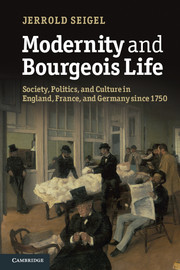 Modernity and Bourgeois Life
Modernity and Bourgeois Life Book contents
- Frontmatter
- Contents
- Illustrations
- Preface
- 1 Introduction: ends and means
- Part I Contours of modernity
- 3 Monarchical centralization, privilege, and conflict: France
- 4 Localism, state-building, and bürgerliche Gesellschaft: Germany
- 5 Modern industry, class, and party politics in nineteenth-century England
- 6 France and bourgeois France: from teleocracy to autonomy
- 7 One special path: modern industry, politics, and bourgeois life in Germany
- Part II Calculations and lifeworlds
- 9 Men and women
- 10 Bourgeois morals: from Victorianism to modern sexuality
- 11 Jews as bourgeois and network people
- Part III A culture of means
- 12 Public places, private spaces
- 13 Bourgeois and others
- 14 Bourgeois life and the avant-garde
- 15 Conclusion
- Notes
- Index
12 - Public places, private spaces
Published online by Cambridge University Press: 05 June 2012
- Frontmatter
- Contents
- Illustrations
- Preface
- 1 Introduction: ends and means
- Part I Contours of modernity
- 3 Monarchical centralization, privilege, and conflict: France
- 4 Localism, state-building, and bürgerliche Gesellschaft: Germany
- 5 Modern industry, class, and party politics in nineteenth-century England
- 6 France and bourgeois France: from teleocracy to autonomy
- 7 One special path: modern industry, politics, and bourgeois life in Germany
- Part II Calculations and lifeworlds
- 9 Men and women
- 10 Bourgeois morals: from Victorianism to modern sexuality
- 11 Jews as bourgeois and network people
- Part III A culture of means
- 12 Public places, private spaces
- 13 Bourgeois and others
- 14 Bourgeois life and the avant-garde
- 15 Conclusion
- Notes
- Index
Summary
The transformation of culture: an outline
The nineteenth century brought a heightened attention to “culture,” both as a particular sphere of life and as a word with varied and disputed meanings. The term now began to take on its two chief modern senses, one referring to the domain of literature and the arts (originally in their “high” rather than “popular” modes, a distinction much weakened today), and the other to the anthropological sense of culture as a “way of life,” what the English Victorian sociologist Edward Tylor called the “complex whole” of values and habits characteristic of some people or group in a given time and place. Many reasons can be cited to account for culture’s new prominence. In a justly celebrated book Raymond Williams showed that “culture” became a point of reference for conservative critics of market society and modern industry in England, who portrayed them as reducing all human relations to what Thomas Carlyle called the “cash nexus,” in contrast to an older, more organic form of life based on humane sentiments and a respect for higher values. The notion of culture also served to distinguish more developed societies from those regarded as closer to nature, and thus to justify the superiority Europeans asserted over peoples in other parts of the world. Tylor used the term in this way, locating particular peoples on a scale of historical development according to how far they had progressed in casting off their original barbarism. Expressed earlier by eighteenth-century writers, this evolutionary view had been challenged by Johann Gottfied Herder, who saw different peoples as possessing a particular spirit that infused all the dimensions of their lives, and argued against claims to hierarchical superiority. But views closer to Tylor’s remained dominant, and Herder’s alternative would only become widespread in anthropological circles after Bronsilaw Malinowski and Franz Boas gave it prominence in the twentieth century.
- Type
- Chapter
- Information
- Modernity and Bourgeois LifeSociety, Politics, and Culture in England, France and Germany since 1750, pp. 413 - 449Publisher: Cambridge University PressPrint publication year: 2012


